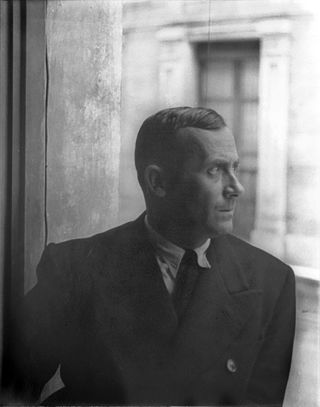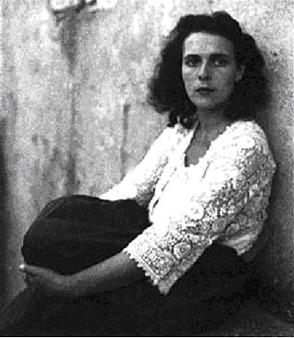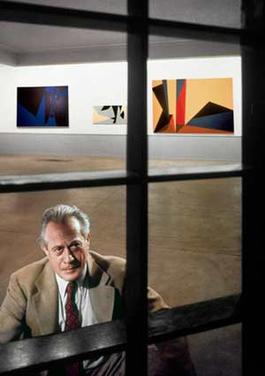
Max Ernst was a German painter, sculptor, printmaker, graphic artist, and poet. A prolific artist, Ernst was a primary pioneer of the Dada movement and Surrealism in Europe. He had no formal artistic training, but his experimental attitude toward the making of art resulted in his invention of frottage—a technique that uses pencil rubbings of textured objects and relief surfaces to create images—and grattage, an analogous technique in which paint is scraped across canvas to reveal the imprints of the objects placed beneath. Ernst is noted for his unconventional drawing methods as well as for creating novels and pamphlets using the method of collages. He served as a soldier for four years during World War I, and this experience left him shocked, traumatised and critical of the modern world. During World War II he was designated an "undesirable foreigner" while living in France.

Joan Miró i Ferrà was a Spanish painter, sculptor and ceramist born in Barcelona. Professionally, he was simply known as Joan Miró. A museum dedicated to his work, the Fundació Joan Miró, was established in his native city of Barcelona in 1975, and another, the Fundació Pilar i Joan Miró, was established in his adoptive city of Palma in 1981.
Gordon Onslow Ford was one of the last surviving members of the 1930s Paris surrealist group surrounding André Breton.

Katherine Linn Sage, usually known as Kay Sage, was an American Surrealist artist and poet active between 1936 and 1963. A member of the Golden Age and Post-War periods of Surrealism, she is mostly recognized for her artistic works, which typically contain themes of an architectural nature.

Richard Diebenkorn was an American painter and printmaker. His early work is associated with abstract expressionism and the Bay Area Figurative Movement of the 1950s and 1960s. In the late 1960s he began his extensive series of geometric, lyrical abstract paintings. Known as the Ocean Park paintings, these paintings were instrumental to his achievement of worldwide acclaim.

Wolfgang Robert Paalen was an Austrian-Mexican painter, sculptor, and art philosopher. A member of the Abstraction-Création group from 1934 to 1935, he joined the influential Surrealist movement in 1935 and was one of its prominent exponents until 1942. Whilst in exile in Mexico, he founded his own counter-surrealist art-magazine DYN, in which he summarized his critical attitude towards radical subjectivism and Freudo-Marxism in Surrealism with his philosophy of contingency. He rejoined the group between 1951 and 1954, during his sojourn in Paris.

Leonor Fini was an Argentine-Italian surrealist painter, designer, illustrator, and author, known for her depictions of powerful and erotic women.
James Timothy Gleeson was an Australian artist. He served on the board of the National Gallery of Australia.

Jarosław Kukowski is a Polish contemporary painter, juror of international art competitions. His works were exhibited, among others Branch Museum of the National-Królikarnia Salons Rempex Auction House, the Museum of Galicia, the Contemporary Art Gallery, Castle Voergaard, the Art Expo New York and many other galleries and museums in the world. He is considered one of the most influential contemporary creators of the Surrealist circle.

Rafał Olbinski is a Polish illustrator, painter, and educator, living in the United States. He is considered one of the major representatives of the Polish School of Posters.

Georges Papazoff was a Bulgarian painter and writer. He became prominent in Paris, worked and died in France. He was among the first surrealists, and was an acquaintance of Joan Miró, Max Ernst and Pablo Picasso.

Mary Leonora Carrington was a British-born surrealist painter and novelist. She lived most of her adult life in Mexico City and was one of the last surviving participants in the surrealist movement of the 1930s. Carrington was also a founding member of the women's liberation movement in Mexico during the 1970s.
Sidney Janis was a wealthy clothing manufacturer and art collector who opened an art gallery in New York in 1948. His gallery quickly gained prominence, for he not only exhibited work by the Abstract Expressionists, but also European artists such as Pierre Bonnard, Paul Klee, Joan Miró, and Piet Mondrian. As the critic Clement Greenberg explained in a 1958 tribute to Janis, the dealer's exhibition practices had helped to establish the legitimacy of the Americans, for his policy "not only implied, it declared, that Jackson Pollock, Willem de Kooning, Franz Kline, Phillip Guston, Mark Rothko, and Robert Motherwell were to be judged by the same standards as Matisse and Picasso, without condescension, without making allowances." Greenberg observed that in the late 1940s "the real issue was whether ambitious artists could live in this country by what they did ambitiously. Sidney Janis helped as much as anyone to see that it was decided affirmatively."

Bernard Dumaine is a French artist best known for his work in photorealism and surrealism styles and for his background designs for television cartoons. He works in a variety of media, including oil paints, acrylic paints, graphite pencil, digital painting, digital collage, and video.

Lorser Feitelson (1898–1978) was an artist known as one of the founding fathers of Southern California–based hard-edge painting. Born in Savannah, Georgia, Feitelson was raised in New York City, where his family relocated shortly after his birth. His rise to prominence occurred after he moved to California in 1927.
Robert Klippel AO was an Australian constructivist sculptor and teacher. He is often described in contemporary art literature as Australia's greatest sculptor. Throughout his career he produced some 1,300 pieces of sculpture and approximately 5,000 drawings.

20th-century Western painting begins with the heritage of late-19th-century painters Vincent van Gogh, Paul Cézanne, Paul Gauguin, Georges Seurat, Henri de Toulouse-Lautrec, and others who were essential for the development of modern art. At the beginning of the 20th century, Henri Matisse and several other young artists including the pre-cubist Georges Braque, André Derain, Raoul Dufy and Maurice de Vlaminck, revolutionized the Paris art world with "wild", multi-colored, expressive landscapes and figure paintings that the critics called Fauvism. Matisse's second version of The Dance signified a key point in his career and in the development of modern painting. It reflected Matisse's incipient fascination with primitive art: the intense warm color of the figures against the cool blue-green background and the rhythmical succession of the dancing nudes convey the feelings of emotional liberation and hedonism.
Jesus Fuertes was a Cubist painter, who was initiated into the world of art by Salvador Dalí, and was described as a "true genius" by Pablo Picasso. Fuertes often chose women and cats as his subject matter. Several of his well-known works involve the use of shades of blue, which earned him the nickname "Painter of Blue".

Justin Summerton is a New Zealand artist and writer, who lives in Dunedin, New Zealand.

Sylvia Fein is an American surrealist painter and author. Inspired by the quattrocento, Fein paints in egg tempera, which she makes herself. She studied painting at the University of Wisconsin–Madison, where she became part of a group of magical realist painters, including Gertrude Abercrombie, Marshall Glasier, John Wilde, Dudley Huppler, and Karl Priebe. A newspaper described her as "Wisconsin’s Foremost Woman Painter." Beginning in the 1940s, Fein lived for a time in Mexico, then in the San Francisco Bay Area of California, eventually settling in the town of Martinez. Her 100th birthday was marked with an exhibition at her alma mater, The University of California at Berkeley.














